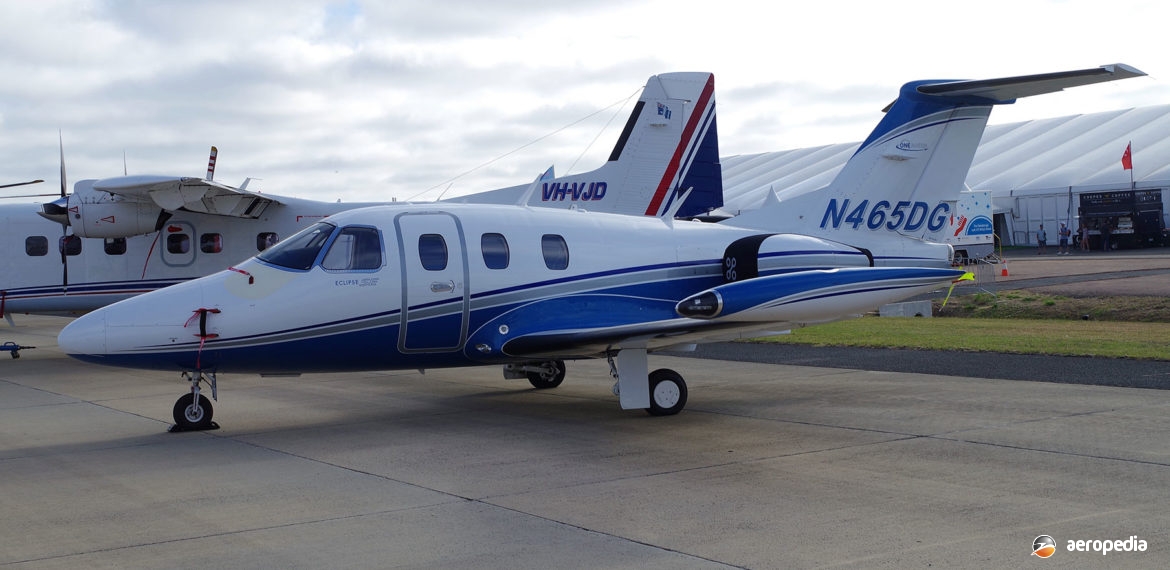Photograph:
First Eclipse 550 N46509 imported to Australia on display at the Australian International Airshow at Avalon, VIC in March 2017 (David C Eyre)
Country of origin:
United States of America
Description:
Light business and executive jet
Power Plant:
Two 990 lbst Pratt & Whitney Canada PW610F turbofans
Specifications:
- Wingspan: 11.6 m (37 ft 9 in)
- Length: 10.2 m (33 ft 5 in)
- Height: 3.4 m (11 ft)
- Wing area: 14.17 m² (141.81 sq ft)
- Max cruising speed at 13,106 m (43,000 ft): 691 km/h (429 mph)
- Max cruising speed at 9,144 m (30,000 ft): 709 km/h (441 mph)
- Service ceiling: 12,000 m (41,000 ft)
- Rate of climb: 1,001 m/min (3,284 ft/min)
- Wing area: 26.5 m² (285.24 sq ft)
- Time to climb to 13,106 m (43,000 ft): 27 mins
- Take-off distance to 15 m (50 ft): 732 m (2,400 ft)
- Landing distance: 878 m (2,880 ft)
- IFR range: 2,593 km (1,611 miles)
- Empty weight: 1,648 kg (3,634 lb)
- Loaded weight: 2,722 kg (6,000 lb)
History:
The Eclipse 550 has been developed from the earlier Eclipse 500 which was built by Eclipse Aerospace from 2010. The Company had some problems for a period but in 2012 PZL Mielec in Poland, a subsidiary of Sikorsky, injected money into the Company, which then became known as One Aviation. It has a facility at Albuquerque in New Mexico where it has recommenced production.
The 550 is a low-wing six-seat twin-engine aircraft certified for single-pilot operation and was first brought to attention at the National Business Aviation Association convention in Las Vegas, Nevada in October 2011. The first example of the new model was rolled out in March 2013 and customer deliveries commenced later that year. The new model initially retained the Pratt & Whitney PW610F engines. It has three 30.48 cm (12 inch) high-resolution displays and a Garmin G3000 Flight Deck. Production of the fuselage, empennage and wings takes place in Poland and final assembly at the New Mexico plant. US FAA certification was received in April 2012.
In 2013, after further development, it was announced the fatigue life limit was 20,000 hours or 20,000 cycles, and new production aircraft incorporated auto throttles, new EFIS software and an anti-lock braking system. European certification was received on 18 November 2015 where the type has been used for air-taxi services.
Further development lead to the “Project Canada” variant which first flew in 2017, this model having a new wing root section which increases the wingspan to 12.7 m (41 ft 7 in) and the wing area to 15.1 m² (163 sq ft), an increase in the fuel capacity to 1,220 litres (268 Imp gals), an increase in useful load to 1,264 kg (2,787 lb) and Pratt & Whitney PW615 engines providing 1,170 lbst.
The first example of the type, like a number of other aircraft imported as business aircraft, has remained on the United States civil aircraft register as the owners indicated it gave them better opportunities to operate in other areas of the world.

